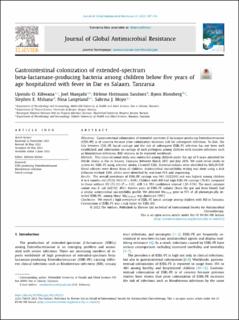| dc.contributor.author | Kibwana, Upendo O. | |
| dc.contributor.author | Manyahi, Joel | |
| dc.contributor.author | Sandnes, Helene Heitmann | |
| dc.contributor.author | Blomberg, Bjørn | |
| dc.contributor.author | Mshana, Stephen E. | |
| dc.contributor.author | Langeland, Nina | |
| dc.contributor.author | Moyo, Sabrina John | |
| dc.date.accessioned | 2022-12-30T14:24:26Z | |
| dc.date.available | 2022-12-30T14:24:26Z | |
| dc.date.created | 2022-09-27T13:45:00Z | |
| dc.date.issued | 2022 | |
| dc.identifier.issn | 2213-7165 | |
| dc.identifier.uri | https://hdl.handle.net/11250/3040120 | |
| dc.description.abstract | Objectives: Gastrointestinal colonization of extended-spectrum β-lactamase-producing Enterobacteriaceae (ESBL-PE) is of concern because prior colonization increases risk for subsequent infections. To date, the link between ESBL-PE faecal carriage and the risk of subsequent ESBL-PE infection has not been well established, and information on carriage of such pathogens among children with invasive infections such as bloodstream infections (BSI) remains to be explored worldwide.
Methods: This cross-sectional study was conducted among children under the age of 5 years admitted for febrile illness in Dar es Salaam, Tanzania, between March 2017 and July 2018. We used rectal swabs to screen for ESBL-PE using selective media, ChromID ESBL. Bacterial isolates were identified by MALDI-TOF. Blood cultures were drawn from all children. Antimicrobial susceptibility testing was done using a disk diffusion method. ESBL alleles were identified by real-time PCR and sequencing.
Results: The overall prevalence of ESBL-PE carriage was 56% (112/200) and was highest among children 4 to 6 months old (17/21, 81%) (P = 0.05). Children with BSI had high ESBL-PE carriage (78.4%) compared to those without BSI (53.1%) (P = 0.02; aOR 3.4, 95% confidence interval 1.20–9.58). The most common isolate was E. coli (64/112, 45%). Sixteen pairs of ESBL-PE isolates (from the gut and from blood) had a similar antimicrobial susceptibility profile. We detected blaCTX-M gene in 97% of all phenotypically detected ESBL-PE; among those, blaCTX-M-15 was dominant (99%).
Conclusion: We report a high prevalence of ESBL-PE faecal carriage among children with BSI in Tanzania. Colonization of ESBL-PE was a risk factor for ESBL-BSI. | en_US |
| dc.language.iso | eng | en_US |
| dc.publisher | Elsevier | en_US |
| dc.rights | Attribution-NonCommercial-NoDerivatives 4.0 Internasjonal | * |
| dc.rights.uri | http://creativecommons.org/licenses/by-nc-nd/4.0/deed.no | * |
| dc.title | Gastrointestinal colonization of extended-spectrum beta-lactamase-producing bacteria among children below five years of age hospitalized with fever in Dar es Salaam, Tanzania | en_US |
| dc.type | Journal article | en_US |
| dc.type | Peer reviewed | en_US |
| dc.description.version | publishedVersion | en_US |
| dc.rights.holder | Copyright 2022 the authors | en_US |
| cristin.ispublished | true | |
| cristin.fulltext | original | |
| cristin.qualitycode | 1 | |
| dc.identifier.doi | 10.1016/j.jgar.2022.05.023 | |
| dc.identifier.cristin | 2055925 | |
| dc.source.journal | Journal of Global Antimicrobial Resistance | en_US |
| dc.source.pagenumber | 107-114 | en_US |
| dc.identifier.citation | Journal of Global Antimicrobial Resistance. 2022, 30, 107-114. | en_US |
| dc.source.volume | 30 | en_US |

